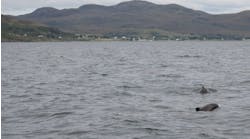PAINTS & COATINGS Low VOC coatings prove worth as corrosion counter-measure
Water-borne and high solids paints are becoming more important in coating specifications for environmental reasons. They contain between 0-35% organic solvents per litre (VOC), compared with standard paints where VOC often contributes 60% or more.
In corrosive environments, long-term performance of the low VOC coatings is now recognized as being fine. Often it is even above that of comparable standard coatings such as alkyd, acrylic and epoxy. However, in corrosive marine environments especially, experience with water-borne coatings remains limited.
Lately, though, the offshore market and independent testing laboratories have proved that coating systems with low VOC and water-borne paints are well suited also for severe corrosive environments. Practical demonstrations and case histories have shown that these systems protect topsides and superstructures against corrosion on par with standard paints, especially where high solid epoxy primers are combined with water-borne acrylic topcoats.
These coating systems could reduce VOC emission by 70% or more, and the cost on an applied square metro basis is not excessive. Painting operators can thereby meet upcoming VOC legislation on a sound economic and technical basis.
Effect of VOCs
When organic solvents evaporate, they are decomposed by the sun's UV radiation. The decomposed molecules are highly reactive and easily form compounds with the exhaust from industrial air pollution.
In Europe and the USA, VOC emission is being addressed by various legislative measures, including an EU directive. This directive requests a solvent management and reduction plan, and sets limits on emission; but it is aimed at the user of the paint, i.e. the painting shops. It is expected that actions laid down in this directive, once introduced, will reduce the solvent emission in the EU member states by 30% in 1999 from 1985 levels.
The painting contractor can address an emission directive by installing an abatement system in his plant, but this could be a costly solution. A better way is to modify the plant and equipment to handle water-borne and/or high solids paints, and to train the applicators accordingly.
Satisfactory performance of paint coatings for protection of steel structures against corrosion is determined by:
- Choice and formulation of the products used in differently classified environments.
- Standard of workmanship and execution of the contract.
Agreement between the client and the contractor as to the specification to be applied is essential to the satisfactory execution of the work. The paint producer may also introduce specifications, or they can be made in accordance with national standards.
High solids paints are normally applied without problems. Water-borne coatings are more delicate because of their nature and their weather window. Most frequently observed mistakes are:
- Water-borne paint mixed with thinners. Result: clogged spray equipment.
- Water-borne paint applied on cold steel and/or at low temperatures. Result: insufficient curing, leading to poor resistance.
- Newly water-borne painted objects exposed to frosty weather. Result: cracking of coating films.
- Water-borne paint used indoors in areas without ventilation. Result: runners and slow drying. All these errors can be overcome by changing the painting procedures and by training the applicators.
Performance
Paint manufacturers, specifiers and societies use a number of accelerated test methods to predict the lifetime performance properties of coatings. Corrosion resistance of coating systems is especially important, and some of the test methods used are:
- Salt Spray Test (ISO 7253, ASTM B-117)
- Continuous Condensation Test (ISO 6270)
- Prohesion Chamber Cyclic Test (No ISO yet).
The salt spray test has been used for a number of years. However, its inability to demonstrate a direct relationship between the resistance of organic coatings to the action of salt spray and the resistance to corrosion in other (natural) exterior environments is now acknowledged. It is, though, valuable in comparison situations for high dft and high solids, solvent-borne systems.
In the prohesion chamber cyclic test the coated panel is dried between the salt spray and UV radiation cycles. Thereby more reliable test results, i.e. with correlation to genuine exterior situations, are obtained.
Water-borne and low VOC coating systems have performed satisfactorily in a number of accelerated cyclic tests in comparison with standard high solvent systems. Results have been confirmed by exterior exposure in aggressive marine environments, such as the offshore sector.
In 1992 Statoil, Saga Petroleum and Norsk Hydro introduced a pre-qualification test for coatings to be used on offshore structures. This test included coating systems for:
- structural steel, exteriors of vessels and tanks, piping (not insulated), valves and steel in non-corrosive areas.
- all decks.
- submerged steel.
High solids/low VOC coating types such as reinforced polyester and solvent-free epoxies have been specified for offshore decks and have performed very satisfactorily over the years. The deck test confirmed their good performance. Similarly, the good experience with solvent-free or low solvent epoxies in submerged areas was verified. Overall, all three systems performed equally in the tests.
The IOZ/vinyl topside system has been used since the 1960s by US-owned offshore operators especially, and is still performing well in the Gulf of Mexico and the North Sea.
During the 1980s the IOZ/HB Epoxy/PU system gradually took over. Important reasons were the lower cost of the paint, and also the possibility of applying coatings in higher film thicknesses, thereby reducing the number of coats, and as a result, application costs. The change was not caused by environmental pressure.
In the 1990s with greater focus on environmental issues, systems employing low VOC products are becoming more important. Also, the isocyanate curing agent in the polyurethanes is to be monitored in, for instance, Great Britain and Norway.
IOZ/HBEpoxy/WB Acrylic is a step towards topside systems formulated with respect for environmental concerns. It has a solvent emission reading of just 217g/sq metro compared with 257g for standard IOZ/Epoxy/PU and 405g for IOZ/vinyl.
Copyright 1995 Offshore. All Rights Reserved.


